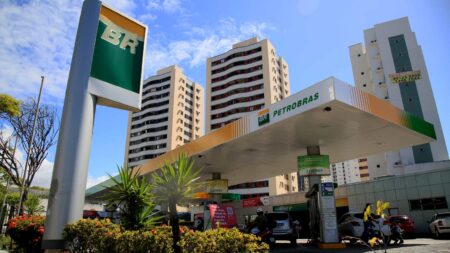Renesas Electronics Corporation (OTCPK:RNECF) Q4 2023 Earnings Conference Call February 7, 2024 8:00 PM ET
Company Participants
Hidetoshi Shibata – President and CEO
Shuhei Shinkai – SVP and CFO
Conference Call Participants
Mikio Hirakawa – BoA Securities
Toru Sugiura – Daiwa Securities
Daiki Takayama – Goldman Sachs
Takero Fujiwara – Citigroup Securities
Kazuo Yoshikawa – Mitsubishi UFJ Morgan Stanley Securities
Operator
Thank you, ladies and gentlemen, for taking your precious time to attend Renesas Electronics 2023 Fourth Quarter and Full Year Earnings Call, despite your busy schedule. Today, simultaneous interpretation service is made available. Please click the globe icon at the bottom of the screen and select your preferred language. The speakers, please turn your video on.
For today’s session, we have Representative Director and President and CEO Hidetoshi Shibata, Senior Vice President and CFO, Shuhei Shinkai, and some other staff members. From now, Mr. Shibata will say a few words and then Mr. Shinkai will present the fourth quarter and full year earnings, followed by a Q&A session. We expect to finish the entire session in about 60 minutes.
Please be advised that the material to be used for today’s presentation, is the one that is posted on the IR site of our homepage. Mr. Shibata, please turn your microphone on and begin.
Hidetoshi Shibata
Good morning to you all. This is Shibata from Renesas Electronics. First of all, I would like to express my sympathy to those who were affected by the Noto Peninsula Earthquake. We look forward and hope that a calm life will be returned to the hands of the disaster victims, as early as possible.
Today, we would like to share the results of the last 12 months’ performance. For the last 12 months, if we talk about our segment, IIoT segment, has seen some production adjustment and that took longer than expected compared to initial assumptions. However, on the other hand, Automotive segment performed quite steadily and that strongly drove the revenue, or supported the revenue.
Of course, we were also helped by the depreciation of yen. So, compared to 2022, the revenue was just down by 2.2%, compared to 2022. As for inventory adjustment or management, reflecting the past experiences, we have been very stringent in the management. Most recently, the Automotive inventory level has come down too low. However, on the part of IIoT, the inventory level is relatively low, but I think it is still at the minimum range of the reasonable level.
So, for the first quarter of this year, the Automotive, steady performance is still continuing. However, looking at the channel inventory, I think we’ll try to expand the inventory level to the normal state. That is something that we need to do. On the other hand, for the IoT, the industrial and also the mass market, we believe the adjustment will continue into the first quarter of this fiscal year.
And at this point of time, we believe the first quarter will hit – see the bottom and then we’ll start to see the recovery from the second quarter onwards, in our view. For the AI-related demand, we are seeing a strong demand for AI-related applications, but this still is very limited in terms of the portion vis-a-vis the total company volume. And of course, we also have some production risks, so, we’ll try to do our best and try to catch up with this growing demand of AI-related.
And this time around, this is the resumption technically, but actually, in reality, it’s more like an announcement of starting dividend payment. And also the treasury shares, we have received so many questions so far, but we’ll try to cancel some of the treasury shares. But the decision that we have made. As for future M&A, we’ll try to actively look into the possibility and acquire assets if that’s deemed necessary.
So, we are not only paying out dividends. We would like to strike a good balance of shareholder return and M&A. So with that, that’s the highlight of the – an outline of the results of the year ended. So more details will be explained from Shinkai-san from now onwards. So Mr. Shinkai, the floor is yours.
Shuhei Shinkai
Yes, this is Shinkai CFO. I would like to present the fourth quarter and full year results for the fiscal year ended December 2023, using the presentation material.
Next page. The next page, the disclaimer. As you can see on the fourth point there, in June 2023, we completed acquisition of Panthronics and the purchase price allocation of this transaction, is reflected in the results. And also, to another reminder, in May of this year, the ERP system integration, the first phase is going to happen.
So in relation to the system integration, the impact on the first quarter results is minimal, if any. However, in the second quarter, there might be some impact. We are expecting some impact and we’ll try to clarify that during the next presentation – of next earnings call. The next point is, that in conjunction with the organization change conducted in January this year, we will review the way of recording revenues in each segment.
IIoT and the Automotive segment will remain unchanged. We’ll continue using this segmentation, but the way of reporting the segment performance of revenues will be divided and we’ll review that. And that – new method will start being applied from the first quarter of this year and we’ll provide you more details at the next earnings call.
And the next page, regarding the fourth quarter performance, if you look at the dark blue columns in the middle there, revenue, JPY361.9 billion, gross margin, 60.4%, operating profit, JPY115.5 billion, OP margin, 31.9%. profit attributable to owners of parent, JPY98.2 billion, and excluding the foreign exchange impact, it was JPY104.9 billion and EBITDA, JPY136 billion and foreign exchange rate was JPY149 to the dollar and JPY159 to the euro. As for the comparison with the forecast, those are written in the three columns on the right. So I’ll come back to this topic later in the presentation.
For the full year results, please look at the dark blue columns on the right. Revenue, JPY1,469.7 billion, gross margin, 57% and operating profit, JPY501.6 billion and 34.1% was the margin. Profit attributable to owners of parent, JPY432.9 billion [ph], excluding the foreign exchange impact, JPY424.4 billion, EBITDA JPY581.9 billion. And therefore our full year currency rate was JPY140 and JPY150 to the dollar and euro, respectively.
Especially on the year-on-year comparison, I have several comments here. So as I talked about the overview view, overall performance was really commented by Shibata-san. Revenue dropped by 2.2%, due mainly to the adjustments in the IoT segment. So overall 2.2% decline, excluding the foreign exchange impact, 6.9% decline year-on-year. And Automotive was up and IIoT also down significantly, excluding exchange impact.
And gross margin declined, due mainly to the deterioration of utilization rate, which resulted in the decline of production recovery. Operating profit, SoC for automotive, IGBT, SoC, those core semiconductors investment resulted in R&D expenses increase. And of course, due to overall inflation cost increases, 3.1% decline in operating profit margin.
The net profit, significant improvement. For one thing, this was due to the change of the intercompany pooling method, which allowed us to minimize the exchange losses. So, we were able to minimize the exchange losses. And so compared on year-on-year basis that had a positive impact towards the gain side.
And also, we also because of the change of the pooling method, we were able to receive interest in income from the dollar deposits. And also the Wolfspeed deposit also gave us some interest income. So those made a positive factor to the profit attributable to the owners of parent.
The next page, Page 5, please. This is the – quarterly changes of revenue. On the far right side, please look at the fourth quarter and the revenue, fourth quarter revenue. Year-on-year, down 7.5% and on Q-on-Q basis, minus 4.6% excluding exchange impact. Year-on-year, down 8.1% and on Q-on-Q, down 6.6%. The automotive and IIoT breakdown as follows.
Please look at them. And the next page, this is the fourth quarter revenue, gross margin and operating profit margin. For this matter, for the overall company performance, if you look at the right hand side, compared to the forecast, operating profit margin was up 1.4%. As for revenue, compared to the midpoint number, it was up 1.1%, but this was due mainly to the foreign exchange impact.
Excluding foreign exchange impact, there was a change in the mix. So for automotive, compared to the forecast, it achieved upsides, but however, IoT, compared to the forecast, was down. So on a net basis, it was almost in line with the forecast. As for automotive, we had foreseen the risk of UWA strike, but that did not really manifest itself. It was nothing. And also the IIoT, especially in the mass market, we have seen adjustment and therefore it performed downwards, compared to the forecast.
As for the gross margin, compared to the forecast, slightly better, up 0.4% point. And the foreign exchange was flat and the product mix up, IIoT down, automotive up. So therefore, deterioration slightly. Production recovery resulted in production adjustment and therefore the utilization was lower and therefore production recovery deteriorated.
On the other hand, because of the positive impact from the reduced expenses and no write-down of inventory, so overall, the performance was slightly better. And R&D expenses slightly down, compared to the forecast. And if you look at the Q-on-Q performance at the bottom right, OP margin down three percentage point, and the gross margin, if I give you a breakdown, this is almost the same as the analysis of the comparison with the forecast, but Automotive up, IIoT down, and mix deterioration and also the production recovery down, because of adjustment.
For the operating expenses. The concentration in the fourth quarter, such as R&D and SG&A, we have seen an increase of these cost items in the fourth quarter. And if you look at the segment numbers on the left hand side, the gross margin Q-on-Q changes. So for the automotive side, the revenue increased. However, within the segment, the mix deteriorated also, because of the production adjustment impact. The gross margin for the automotive business slightly deteriorated on a Q-on-Q basis. And for the IIoT operating margin, because of the decreased revenues, we have seen a significant OP margin decline on a Q-on-Q basis.
Next page, please. So these are in-house inventory. So the overall DOI as a Q-o-Q has gone down and end of fourth quarter is 93 days. So automotive, IIoT has declined and in terms after the value and in terms of DOI.
Next slide, please. So this is a sales channel inventory. Overall, Quarter-on-quarter, it has slightly increased. It is slightly over nine weeks. Automotive has declined. It is around 8 weeks for the IIoT has increased to about certainly above 10 weeks. But automotive, we have initially anticipated an increase. However, as I said, AAA – impact was minor. And there has been a lot of inquiries coming from the customers.
So the inventory level has gone down by IIoT as has been predicted – has been as predicted, the sell-through for advanced market has declined. On the other hand, the sell-in has decreased in terms of the inventory level, it is basically in line and basically a slight increase.
Going to the next slide. So this is inventory analysis. First, on the left-hand side, this is the in-house inventory. The third quarter to fourth quarter, compared to the projection, we have increased the production adjustment. For instance, for the mass market they did on purpose on CU products. Based on the demand outlook, we have increased the range of the production adjustment.
So the recompress has gone down, the finished goods. We haven’t conducted product less production, basically they conduct shipment in line with the demand, so it has gone down slightly. For the first quarter – in the first quarter, we are anticipating a second quarter recovery, and we are planning to increase the production slightly. On top of that, for the Naka [ph] plant, the 40-nano MCU for the automotive sector, we are trying to accumulate the Dipan, and we’re going to start the accumulation. So in terms of raw materials and the work in progress, for the next fourth quarter, it’s going to go up.
On the right-hand side, this is the sales channel inventory for the fourth quarter. I talked about this already. For the first quarter for the automotive sector for the fourth quarter it has gone down, but we would make start. In terms of the level, it’s going to go up. On the other hand for the IIoT, we will conduct shipment in line with the demand. It means that we’re going – anticipating a slight decline. But going forward, we do want to not reduce the inventory too much. That is our policy.
Next slide, please. This is the utilization rate.. This is for up is the wafer input base utilization. Fourth quarter, it was a little under 55%. It was slightly down lower than anticipated for the first quarter is going to go up from this point. I have talked about the for the second quarter. We’re going to increase the production and the Naka plant dye bank production is going to contribute.
Next slide, please. This is the gross profit margin and operating profit margin, please refer to these numbers.
Next slide, please. This is EBITDA and free cash flow. On the right hand side, free cash flow. So for the deposits are provided to – with speed, we have excluded that for the fourth quarter operating cash flow is JPY152.4 billion. Free cash flow is JPY103.2 billion. So the difference between the fourth quarter, is that basically a normal level. But this is a corporate tax payment and the bonus payment.
Next slide, please. This is the FY 2024 first quarter outlook. So please look at the column, the dark blue one on the middle. In terms of the revenue, the EBITDA point numbers JPY345 billion. Q-on-Q, it’s at minus 4.7%. If we exclude the ForEx impact, it’s minus 2.9%. So the breakdown of this is automotive is going to slightly increase. IIoT is going to go down. And net-net, we’re going to see a decline in the revenue.
In terms of the gross profit margin is 55%, Q-on-Q is minus 1.4 percentage points. Major reason behind this is the, due to the change of the sales of the product mix is going to deteriorate, increase of the production costs, because of the ramp-up of the Kofu plant, we are including that as well. On the other hand, production recovery, because of the utilization rate improvement. It’s going to cover side in total, it will be going down. In terms of operating margin, it’s 30%. In terms of the forex assumption JPY142 to the dollar, JPY155 to the euro.
Then going to the appendix portion. Please go to Page 22. This is about CapEx. Fourth quarter centering on R&D-related investment against the sales, it’s 3.4%. For the first quarter, in terms of the scale, it’s about it will be the 1% level against the sales. Please go to Page 23. This is about the acquisition of the Transform this – we have acquired company Transform, which is engaging GAN.
Next slide, please. This is about dividends and the cancellation of the treasury stock. On the left-hand side, in terms of the dividend, it will be JPY28 per share, so JPY49.8 billion in total, we will have decided to pay out this level of dividend. Going forward, we will continuously and a stable dividend payment, we will try to commit to that. On the right-hand side, this is about the calculation of the treasury shares. And we have clarified our policy about the treasury stock holding, and we have decided to partially cancel. So the upper limit of the treasury stock of 5%, if it exceeds that level, in principle, we will cancel. As for this 5% treasury shares, this will be used for the mid to long-term incentive for our employees. So that this, I would like to end my presentation. Thank you.
Question-and-Answer Session
Operator
[Operator Instructions] BoA Securities, Hirakawa-san. Please begin your question.
Mikio Hirakawa
BoA Securities. My name is Hirakawa. I have two questions. First, regarding the comment from Shibata on the outset. You mentioned that the automotive and IIoT semiconductor trend in the first quarter and also the outlook for the 2024, if you could also give some indication when starts, things will start to recover. At which point things will start to recover. And my second question, my second question, the supply/demand of semiconductor, we are aware that these are changing. In this environment, semiconductor price has held steady, but can you comment on how the prices are changing between automotive and nonautomotive. Can you provide your comment, between automotive and nonautomotive?
Hidetoshi Shibata
Yes, I’ll do so. The first quarter automotive in our view, compared to the fourth quarter, we believe it will fare flattish, compared to the fourth quarter. The fourth quarter, as Mr. Shinkai explained to you, the fourth quarter for some customers, because of the production coming in the last minute, the end demand was longer compared to our initial assumption. But in the first quarter, however, because of the Chinese New Year and so forth, the basic trend is that we are seeing a steady trend.
But on a Q-on-Q basis, we believe it will be flat. Our revenue in terms of our revenue, we have to ramp up the inventory in the channel. So therefore, we are expecting a slight growth in our revenue. As a basic trend, I don’t think the basic trend will change rapidly, or significantly from the second quarter onwards in our view right now. The automotive production quantity overall is estimated to be nearly flat in our business plan.
And also, it’s about the content increases. Maybe the content increase will be slower, compared to the past, but we will continue to see a double-digit growth. So some EV, there are some headwinds in the EV area and the China market, becoming increasingly competitive. But overall, I would say the trend will remain to be steady. As for the industrial infrastructure and IoT.
If you divide the industrial versus the mass market and also for the Japanese market, the inventory adjustment, compared to other segments, started after or later, and I think that is still – and that’s the reason why the adjustment is still continuing. And also therefore, this may continue into the first quarter, or maybe into the second quarter as if this has U shaped recovery.
So that we believe the second half – in the second half we’ll start to see the recovery in these segments. As for PC, as we have mentioned last time, we already hit the bottom. So it will go up and down based on the cyclicality of the market. So, it will improve in the third quarter towards the third quarter and maybe come down again in the fourth quarter. That is the curve that we are projecting for the PC market.
And also data center and AI for data center and AI, these account for a very small portion in total revenues. Let’s say, it’s about only 2% to 3% of our total revenues. If you comment on the size of this business, but I think we are expecting a strong growth in this area. So we’ll try to skillfully catch up with our product injection and also the production. If we are able to do so, I think this will underpin strongly the IIoT performance.
And prices well between automotive and nonautomotive, we are not foreseeing a significant gap in between them. But as you have guessed precisely. Up until last year, the uptrend of prices up until last year, I think we might see a reversal this year. Although we are not expecting a significant decline in prices, however, because the competitive landscape is changing significantly. So I think a slight price downturn is something we have foreseen this year. Did I answer your question?
Mikio Hirakawa
Just one last point. Regarding the price decrease, I think usually happens. But what is the impact on the gross margin that going to be offset by the productivity improvement, or the volume increase. So is that the price reduction that you can anticipate? Is that the level?
Hidetoshi Shibata
Well, I’m not really sure if you can completely offset the impact, but we are not expecting a severe decline in gross margin. I think which we should be very able to manage in that way. And also, the depreciations will also increase, because of the part of the operation of some plants. So that’s going to be some challenges for us, but I don’t think we have to anticipate a significant decline that will – worry you. Thank you.
Mikio Hirakawa
Thank you very much.
Operator
Let’s go to the next question from Daiwa Securities. Sugiura-san, please ask your question. Please unmute yourself and speak up.
Toru Sugiura
This is Sugiura, Daiwa Securities. Thank you for taking my question. So my side, I have one large question. But on the first quarter, utilization is going to improve. But specifically, so for first quarter, what will be the actual utilization rate? And if possible, from the second quarter onwards, how is, the utilization rate is going to trend. That’s number one. And number two is Shibata has mentioned that FY ’24 automotive semiconductor double-digit growth can be expected. Within this, for you against the market, where will you underperform and where will you outperform the market? So – and in totality, how you’re going to perform in this market, I would like to hear about this.
Hidetoshi Shibata
So I have been — let’s answer the second question first. And the further question, Shinkai will answer. So compared to before the ADAS and EV sales within our automotive business has been increasing compared to before. But that said, it’s still about 15% against our whole automotive business. So ADAS – well, my EV is adjustment phase I think the ADAS led growth in market will continue.
For the automotive overall total business volume, it’s still currently it’s 1% plus that’s going to grow. So 85% of automotive business is ADAS, non-ADAS, non-EV business, and that will drive our business in the automotive area. So, we are forecasting a kind of robust business, but the competitors have a logic exposure to ADAS or EV, compared to them, maybe a growth level will seem a bit weak.
So, I think that’s the situation that we are in. So utilization rate as sound as – for the fourth quarter to the first quarter, the one single digit or the earlier 1% level of improvement will be made, but the second quarter was 1% plus level of the Q-on-Q improvement of utilization rate, but there’s some technical issues. So, I’ve talked about the 40-nano MCU the Naka plant, dye bank accumulation.
This will contribute to the utilization rate. The increase of production is going to be started it’s going to be from March. So the – so in terms of the first quarter was one-third of contribution, the second quarter onwards, the contribution is going to be more. So that would be the driver of the utilization rate, but besides that, there will be some same changes depend on the changes in the demand. That’s all from me.
Toru Sugiura
Thank you very much. This is a follow-up question. Shibata has said that you talked about ADAS and EV, so in the in terms of the, that you have been able to capture from the past, doesn’t that contribute to your future business? In terms of the ADAS business, I think basically, it will smoothly ramp up?
Hidetoshi Shibata
So I think there will be no surprise, whether that’s a good thing or a bad thing. For the EV side. And a lot of people have more interest in this business. But – so mainly in China, in the past year, the market environment has changed dramatically. So compared to before, compared to last year to this year, actually, I think of the intent so that you’ll wasting server to see the IGBT, for instance, will seem to be facing a tougher situation.
So from the perspective of IGBT, with the non-Chinese competitors. I think our situation will be that different from them. But from SIC mainly in SIC, compared to the competitors that we’re competitive. So I think competing SIC, maybe we will see that we’re slowing down. But we will produce a Kofu plant and ship products that were there application in terms of clients that we’re going to provide from the Kofu plant.
Luckily, they will not be dramatically impacted by the situation that’s happening in China. So maybe there will be some ups and downs – but I do not think that things will go as we planned. In terms of the Kofu plant will ramp up and the IGBT business will ramp up as well. Thank you.
Toru Sugiura
Thank you so much.
Operator
Thank you. Now I’d like to move on to the next question from Goldman Sachs, Takayama-san. Please begin your question. Please unmute yourself and make your statement.
Daiki Takayama
Hello. Thank you very much. Hello. Thank you for this opportunity. My first question relates to automotive. In the last earnings call, you said that in the end of December, Europe and also in the mid of March, in Japan, there will be some year-end adjustments. So how did that turn out? Can you comment on that? And also, if you can just clarify the trends by each region? And also received a question regarding the semiconductor automotive overseas your business, your performance is quite favorable. Maybe this is due to the difference of contract difference of the inventory level. But from your perspective, from your company’s perspective, why do you think you are resilient in automotive business? What is the difference of yourselves vis-a-vis your competitors overseas competitors?
Hidetoshi Shibata
Yes. Well, I don’t want to be to show off so much, but this is something we are talking about for some time. But in the COVID environment, in a very tight situation, we believe we have been communicating quite frequently with our customers. So we’re asking customers not the purchase if that’s not really needed for them. And we’ll try to supply if the product is really strongly needed by the customer.
So this is the approach that we have been taking for some time since last year. So therefore, that has given us customers’ confidence and they are purchasing orders, for things that they really need. And we received this question regarding the automotive inventory adjustment, and I think things have not changed that much, compared to before.
By region, by segment its money the fact that we have a universal situation regarding inventory adjustment, or something universal when it comes to the excess or shortage of inventory. But on a spot by – spot basis to some specific customers, there are some overshooting and then after an over shift there is an adjustment.
So ifs over-shift it’s upwards or downwards. So those kind of adjustments are still taking place as we speak right now. So if you look at the overall picture, there are some oversupply and undersupply in some areas, but the overall situation remains in line with the business plan. So we are continuing our shipment. So the automotive – so as the long as automotive market remains solid.
I think, we can expect our revenue to continue to perform steadily. That’s how we look at the market. Well, in the end of December, Europe and also in the end of March, the year-end adjustment did not really take place as much as you had anticipated. We didn’t really see any significant adjustment. Actually, in the fourth quarter and the end of last year, there was a strong adjustment, especially amongst the Japanese customers last year.
But at some customers, of course, there was a suspension of production and also shipments. So — and towards the end of March, we might see that going forward. However, we are not really convinced by local – at least after — of course, there’s the China, rest in China but the current market inventory will come — will be actually adjusted significantly towards the end of March.
Daiki Takayama
My second question relates to the location of your capital especially I’m talking about your share buyback and dividend program. You made this announcement this time around. So from here onwards, do you plan to raise your dividend level going forward? Or would you might rather try to maintain this level of 14.8% of payout ratio and focus more on the share buyback, because I think you also have to think about the share disposal of major shareholders. So what is your priority? I think that last year, I think paying our dividend was the first priority. But what is the priority going forward? If you can share your thought process?
Hidetoshi Shibata
Well, we’ll try to steadily and cautiously raise our dividend level. That is our plan. And for share buyback, it depends on the prevailing market situation, conditions and also, of course, the shareholder return is very important for us. But we also are looking into strategic investments, especially M&A we’ll look at both opportunities.
And depending on situation, if you are able to purchase shares at attractive prices, we will prioritize share buyback. But if that’s not the case, we’ll try to prioritize strategic investments. So strike a good balance looking at both sides. A supplementary question. Maybe this is not a question to you, but if the your major shareholder release.
Daiki Takayama
Would you like to absorb that through share repurchase as a possibility?
Hidetoshi Shibata
I will not rule out that possibility, as a possibility that might possibly happen, but that is not the center of my thoughts right. Thank you.
Daiki Takayama
Thank you very much.
Operator
Let’s go to Citigroup Securities, Fujiwara-san. Please. Please unmute yourself and state your question
Takero Fujiwara
So, hello. This is Takero, Citigroup Securities. Fujiwara speaking. So, I have two questions. First of all, my first question is with the — this is — you talked about the industrial mass market, Japan, and the inventory adjustment started later and is still continuing. I think you have stated that. So specifically for industrial lifetime course of a concern. Well, the Chinese economy is decelerating and for the industrial market adjustment, within your for you, do you really feel that? Do you feel that the deceleration for the Chinese market and for the industrial and for the mass market, how is the inventory adjustment going forward? How far has this adjustment gone? So that’s my first question?
Hidetoshi Shibata
Well, yes, specifically for the impact of the Chinese economy, I myself is very concerned about this matter. But how what is coming from the discoloration of the Chinese economy, how much is coming from the inventory adjustment. It’s very difficult to divide these 2. So I talked about the first quarter, second quarter being the kind of the bottom of the U-shaped recovery curve. That will be the same of adjustment.
So I’m not anticipating after we closed the quarter in March, and that is concern covering the April, I think the customers will be more cautious in terms of production and purchasing. For the second half, A lot of people have been saying that the market is going to recover. So I think that is within our view.
Takero Fujiwara
Understood. So you talked about how far the inventory adjustment has gone.
Hidetoshi Shibata
Well, I do not think that everything is going to end in the first quarter. I think basically, this condition continuing into the second quarter.
Takero Fujiwara
Understood. My second question is as how you’re thinking behind the numbers. So the first quarter for extensivity I would like to know about that, that’s number one. And 2023, you have been proactively hedging against the currency. 2024 [indiscernible] 2024, how the ForEx hedging situation is going to change? How much you can enjoy the weaker yen? I’d like to know about that.
Hidetoshi Shibata
So Shinkai will answer the question. Shinkai.
Shuhei Shinkai
In terms of the hedging policy, would it be 2024 with the same policy in 2023, with the dollar and for the 2024 for us euro, partially have hedged. So we have the cap and the floor. So we have a color-based hedging. And in terms of the impact that the — excuse me, for the impact of the ForEx for the first quarter, the dollar, if it’s — you change JPY 1 in terms of revenue, JPY1.3 billion impact in terms of the gross profit is JPY 600 million, operating profit, JPY300 million, that will be the impact.
For the euro, JPY200 million, JPY200 million, JPY100 million, in the same order. That’s all. So this is the confirmation. So for the FY ’24 hedge compared to 2023, it is — the gains going to depreciate more. And in terms of the sensitivity, it’s the nonhedge portion sensitivity that was within the hedging portion. And the hedging rate, FY ’24, it’s going to be slightly weaker on the side.
Takero Fujiwara
Understood. Thank you very much. That’s all from me.
Operator
Moving on to the next question. UBS Securities. Yasui-san, please begin your question. Please unmute yourself and begin your statement.
Unidentified Analyst
Yasui [ph] from UBS Securities. Thank you. This relates to the previous question relating to the foreign exchange impact. In the presentation material, Page 11, you have given the gross margin trend. And if you look at the gross margin improving in 2022 and then going up again. Is this impacted by the foreign exchange because that’s how I see it. So if you talk about the sensitivity to foreign exchange, seems that it’s not really significantly impacting. But in terms of gross margin profit – gross profit margin, I think the foreign exchange had a call on you. So I’m not really sure if the size of the impact is so small, JPY600 million by JPY2.4 billion. And I think it’s by $2billion, I think JPY550 billion, will that be the upper limit.
So then the modem will be JPY200 billion to JPY200 billion. So if you maybe has a JPY 40 billion impact altogether, if you multiply that by 4. So if you could again elaborate on the your philosophic on foreign exchange and of course, last year, in the 1-year period, do you think your market share has increased or was it flat? If you can give us some color by products. So that’s my first question. The second question is about the acquisition of transform. So with that, you now have wide gap and also 3 types of wide gap power semiconductors now on your hand. So the wide cap semiconductor, I think, is now drawing attention. So in the market, it seems things are getting more interesting. So you can share with us your aims or the markets you can target with this new acquisition, if you can share that point.
Hidetoshi Shibata
So Shinkai will answer the first question, so please begin Shinkai.
Shuhei Shinkai
Well, the gross margin vis-a-vis the foreign exchange impact. Actually, in 2022, 2023, if you look at these numbers here, in 2023, we have conducted hedging. So also that has an impact. And also the foreign-denominated currency vis-a-vis the total cost of our goods has not been significant. So therefore, then in 2023, the gross margin Q-on-Q changes here.
What was the factor behind this? Actually, it’s not really a foreign exchange. It’s rather the inventory write-downs, for example. And so those irregular factors also had a bigger impact on the COGS. So that’s dragged more by these other elements other than foreign exchange. So that’s my explanation.
Hidetoshi Shibata
Wide band gap, it’s not really — we don’t really have a very peculiar special idea for wideband gap. So SIC centered on inverter, we would like to address these demands. And also again, of course, as you know, power supply or charge related applications are the areas we would like to target, and we would like to enter those business opportunities. Of course, it’s going to be very difficult like technology as technology matures, the market adoption also changes. So it’s a chicken and egg story actually.
So – but sure, if I look at things from a mature perspective, GaN offers a great potential. So I adoption has started in a big way already. So I think in that regard, we are very strong. But the way that materials are built today and the ease of processing or the difficulty of processing when you consider all these things, if we can successfully mature the GaN technology and expand the application of GaN, to a broader spectrum than what we foresee right now. If we can exert leadership towards that direction, that will be great.
That is what we have in our mind. Of course, this is going to be taking a long time. But the gain is a very interesting material. We have high hopes for that, which is something that we have had in mind for some time. So at last, we have our technology on our hand. So we are very pleased, and we are looking forward to this very much, right? So the market share trend. Just as a guard feeling, if you can just give us some color per share, I’m not really sure, but China, the power products in China.
We are obviously losing market share. MCU globally, we think there are some ups and downs. But I think for automotive, I think we are performing steadily. But other than automotive, 2 years ago we were able to secure a strong market share, but there might be some reactionary decline as a result of that. But structurally, winning or structurally losing. That is not really the case. We rather [indiscernible] a change in trend, I think. So overall, MCU buy and laws I think we are maintaining our market share.
That’s a picture that we are seeing right now. And power, we are struggling in China. SIC, it’s not really adequate for us to talk about this as a market share because these are. There’s a spiky trend as a result of individual negotiation outcomes. So the fourth generation devices will start up from next fiscal year onwards. So then once that becomes available, I think we shall be able to show you some powerful performance. Thank you.
Unidentified Analyst
Thank you very much.
Operator
Next, for Nikkei BP, Kojima-san, please unmute yourself and state your question.
Unidentified Analyst
This is Kojima [ph] for Nikkei BP.
Hidetoshi Shibata
Can you hear me?
Unidentified Analyst
Yes, we can hear you. I have 2 questions. One is, this is about a detailed question about the product. So I think you talked about the applications in your presentation. And my question is twofold. The data center AI, the sales is going to grow. You talked about that. More specifically, what spec products are you talking about? And for the automotive application with semiconductor automotive, EV, ADAS. The portfolio is still low. 85% is coming from the non-ADAS EV area. So what will be the mainstay product in this 85%. Can you mention that? That’s my first question.
Hidetoshi Shibata
The data centers and AI, mainly, this will be the power semiconductors, power controllers, power switches. Of course, timing and various other semiconductors, of course, this will be sold to the AI market. But specifically, what stands out is and it’s going to grow will be power conductor. But the data center overall, as I have said from before, DDR5 transition. Remember, standard is going to be established.
So on a quarter-on-quarter, maybe this memory business will be fluctuating. But year-over-year from last year to this year, it will steadily grow. I think that’s going to happen. So for the data center overall, memory interface and power. Within that, if you specifically talk about AI, power semiconductors will be the main product. I think that will be a precise picture in terms of the automotive business. So MCUs will be a mainstay product, and SoCs.
So I repeat myself, but this is a kind of a, you know, by project by project, different products. So it’s running on, that is quite lumpy, but as a trend, a world trend, this will grow. And analog and power semiconductors, we will steadily grow this business. And so the overall MCU ratio goes down. I think that will be a good picture for us.
Unidentified Analyst
Understood. Thank you very much. My second question is, so I do understand that you can talk about the future. But from the end of last year, we just TDS. So SCS that the market is going to increase by 30%. That has been the outlook. So what do you think that will reach that level? Shibata, your personal view?
Hidetoshi Shibata
For semiconductor overall, overall, I think that’s the story. But we’re not engaged in HPM. The last year, so some things has dropped last year and there will be a kind of rebound this year. That’s the memory. So due to generative AI, HBM that’s going to be sold lighting.
We are not engaged in those type of products. We — in terms of the targeted market, double-digit growth. You don’t see the market growing by double-digit growth for our specific market — so I hope that the market will grow steadily. That’s my view.
Unidentified Analyst
Thank you very much. That’s all from me.
Operator
Moving on to the next. Mitsubishi UFJ Morgan Stanley Securities, Yoshikawa-san, please begin your question. Unmute yourself and please begin.
Kazuo Yoshikawa
Morgan Stanley, Yoshikawa is my name. A very brief question. This time around the full year tax — the effective tax rate, I think, was about 20%. Before that 29%, so the fluctuation is quite rough, so I just want to ask this question. So going forward, what would the effective tax rate that we have to anticipate? If you can comment on that, that would be appreciated.
Hidetoshi Shibata
Shinkai, can you comment on that?
Shuhei Shinkai
In 2022, because of onetime factors, but in the future, 2023, 20% or so, is something that we have in our mind. Thank you.
Kazuo Yoshikawa Thank you very much.
Operator
Next. From Nikkei newspaper, Nukano-san, please. Please ask your question. Please unmute yourself and please ask your question.
Unidentified Analyst
So Nukano [ph] from Nikkei newspaper, thank you for taking my question. So the transform that you have decided to acquire in terms of R&D system and the product manufacturing consignment is done in Japan. So what are you thinking to do about the structure the policy for the GaN overall, are you going to produce in the other plants in Japan? Are you going to do internal production? So what is the policy about GaN production. So what’s your view currently? That’s my first question. My second question is that for the automotive business, you talked about for the first quarter, Q-on-Q, your outlook is flat. If we compare to the past, it has become better or weaker? So for instance, we have the strikes this has been an impact on your business?
Hidetoshi Shibata
So the automotive Q-on-Q outlook, it is in the case if you changed your outlook. So again, it’s something for the future. We can’t say for sure. But currently, in terms of the R&D, most of it is the conduct in Santa Barbara. So the mainly [indiscernible] Barbara.
So the — in terms of the composite, I think it’s a global class people that are there. and so with the center. In terms of production, same goes to SIC — we have our own plants. So with their own plans going forward, it will take some time. But if we can produce in our own plant, I think that will be the best scenario for us. Thank you.
Unidentified Analyst
Thank you very much.
Operator
We are running out of time. So this will be the last question. The last question is from JP Morgan Securities. Shin-san, please begin your question. Please unmute and begin your question.
Unidentified Analyst
Can you hear me?
Hidetoshi Shibata
Yes, we hear you.
Unidentified Analyst
Thank you very much for this opportunity. I have just two brief questions. One is just for reconfirmation. Power semiconductors, SIC samples, I think, has been submitted. So what is your feedback from customers for the SIC semiconductors? And as that change our future direction, future strategy as a side of these feedbacks. And the second question is a more big picture question. You have enjoyed tailwind over the last several years, and that tailwind has been — has ended. So I think also changed the global HR Head. So in 2024, I believe 2024 will be a decisive year that will be a demotion for you to win or lose vis-a-vis your competitors. So I think we’ll see that in 2024. So what will the sales strategy, how to change or you use of distributors. So if there’s any changes planned for the sale, please share with us?
Hidetoshi Shibata
The Chanel or direct in terms of sales, actually, we would like to have a solid partnership with the channel, and that is our strategy. We don’t want to bring everything on her own umbrella for direct sales. So this is not going to change dramatically in that regard. So however, the important point is that you don’t want to change our strategy because this is a good year, bad year like the last several years of initiatives have delivered certain results. So we strongly believe that we have been able to deliver results.
So from here onwards, we would like to continue to make investments for our longer-term perspective. And in order to achieve that from January of this year, not based on segments, we have decided to reorganize the organization based on product based on technology rather than segment. So — and I think the effect of this transformation or reorganization is now becoming visible. So previously, automotive and industrial, there were some overlapping development. So we decided to put them together, and these things are happening here and there inside the organization.
So like the same human resources or the same amount by applying the same amount of resources, be it the human or our money, the will be greater compared to before because of this reorganization. But as you know, semiconductor all the things that we are doing today. And only deliver as a result several years back or later or years later. So in order for you to appreciate all these deliverables from these initiatives, I think there will be a time lag. But I think so far so good. I think we got off to a good start. Thank you. That’s it for myself.
Unidentified Analyst
What about the power semiconductor and SIC feedback from customers.
Hidetoshi Shibata
Well, nothing really in particular. The sample is only at the initial phase. So many of the customers will give us favorable comments usually, so they just give a favorable comment. The product is good. So they expect mass production to happen as early as possible.
So we have to discount those comments as we hear them. But so far, I think things are moving favorably. Thank you. That’s all for myself.
Unidentified Analyst
Thank you very much.
Operator
With this, I would like to end the Q&A session. So Mr. Shibata a word please at the end.
Hidetoshi Shibata
So automotive business has been solid and AI, we can expect growth. and the industrial mass market is during the adjustment phase. And for the other businesses, with consumer in an economic cyclical market, I think we have seen this kind of distinct differences to the markets in this earnings report. So towards the second half of this year, in terms of utilization with our plans and increasing our inventory cautiously, but at the same time, not to be too cautious. I think we have to be careful in how we drive this in on rigs or putting on putting our foot on the gas accordingly. Thank you very much for attending our presentation.
Read the full article here












